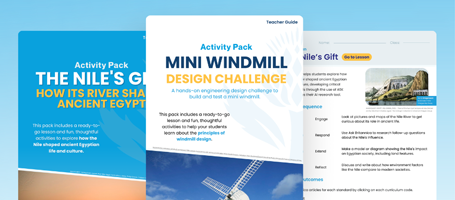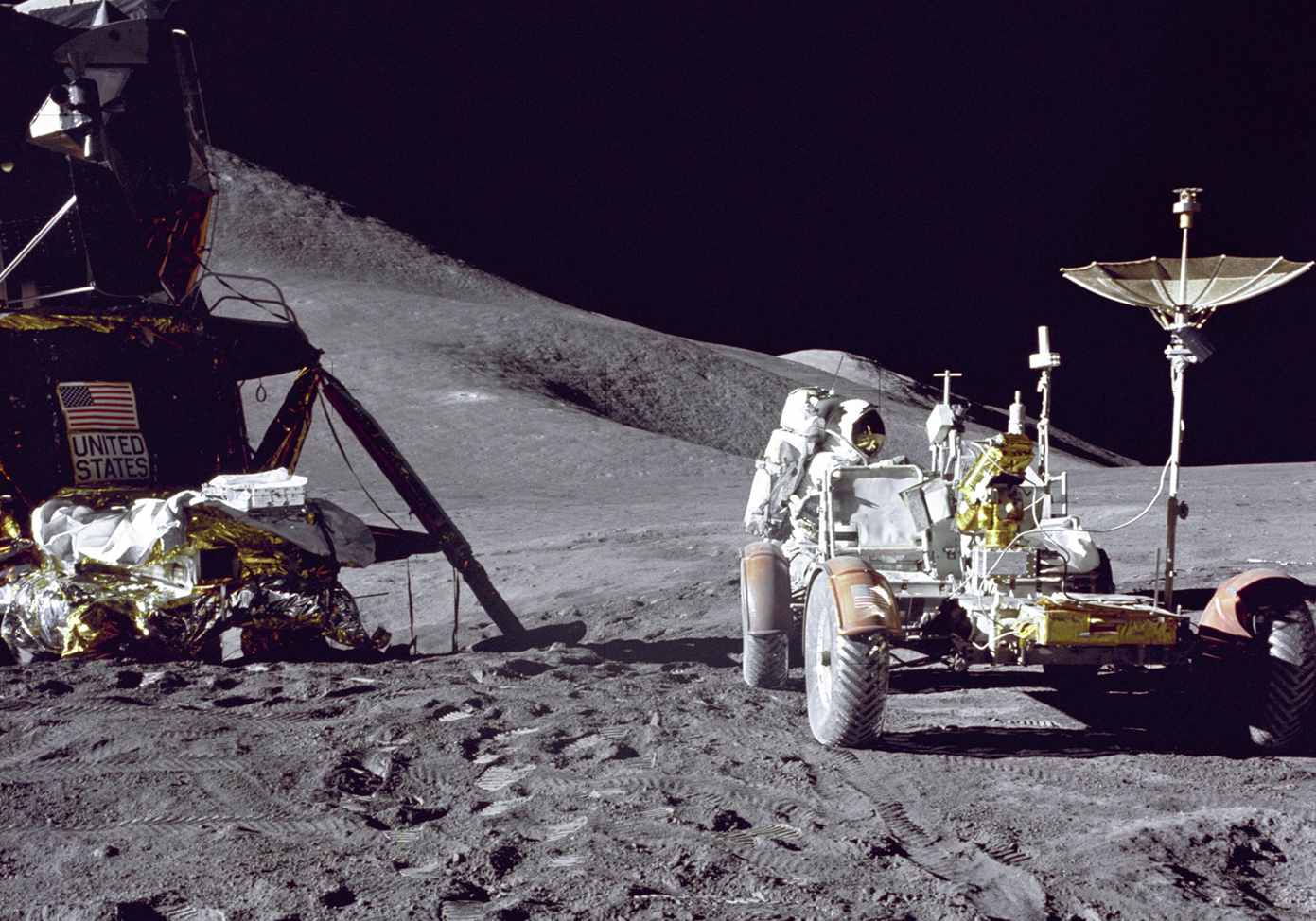Over the course of human history, we have gone from observing the Moon from afar to engineering our way onto its surface. Now 50 years after we landed the first man on the Moon and the world is asking “what’s next?”, let’s take a look back at the people, the science and the fascination that got us here. Mission Launch: Destination Moon!
The following activities have been created to supplement resources from Britannica School. They can be used as a guide for lessons around the topic of the Moon. Contact your librarian to find out if your institution already has access to Britannica School or claim your own free trial!
Unit Title:
The Moon
Years:
F-8
Key Learning Areas:
Science
Curriculum Links:
Australian Curriculum
ACSSU019 Observable changes occur in the sky and landscape. Recording short – and longer – term patterns of events that occur on Earth and in the sky, such as the appearance of the moon and stars at night, the weather and the seasons.
ACSSU115 Predictable phenomena on Earth, including seasons and eclipses, are caused by the relative positions of the sun, Earth and the moon.
Elaborations
- Investigating natural phenomena such as lunar and solar eclipses, seasons and phases of the moon.
- Comparing times for the rotation of Earth, the sun and moon, and comparing the times for the orbits of Earth and the moon.
- Modelling the relative movements of the Earth, sun and moon and how natural phenomena such as solar and lunar eclipses and phases of the moon occur.
Assessment:
- Various work samples based on tasks completed e.g. Moon Diagram, Venn Diagram, presentation
- Observation of students as they research and work through the task elements
- Observation of discussions
Resources:
- Internet access
- Device
- Venn Diagram
- Main Idea Worksheet
- KWL Chart
- Flow Chart
Introduction: Destination Moon!
The most prominent feature in the night sky is Earth’s natural satellite, the Moon. The Moon is most obvious at night, though it is commonly visible in the daytime as well.
The Moon’s prominence in the sky and its regular cycles have always captured the interest of people around the world. It has been used for very practical purposes such as timekeeping, while also becoming a popular subject of legends and superstition.
Teaching Strategies / Learning Experiences:
The following resources and activity sets can be expanded into lesson plans or community events, distributed as guided study resources or used to frame group discussions. Supporting media can be displayed on an interactive whiteboard or projector to encourage collaboration in a classroom environment.
Activity: What Do We Know About the Moon?
Share images of the Moon with the class. Using these images, students complete a KWL chart identifying what they know about the Moon and what they would like to know about the Moon.
Maria: Moon
Moon
Moon: Craters and Valleys
Moon
Activity: Life on the Moon
Can things grow on the Moon? Could people live on the Moon?
Read the Britannica article Moon. Other good resources to use include videos “Living on the moon!” from ABC Splash and “Moon 101” from National Geographic.
Have the students think about the ideas presented from the article and in the videos. Using the Venn Diagram, students compare life on Earth to life on the Moon…if it were possible!
Did You Know? The Moon is the only place in space apart from Earth that humans have set foot on.
Activity: Illustrate the Moon
Students illustrate a labelled diagram of the Moon, depicting key features i.e. landforms, craters, hills, mountains, rocks, plains, “seas”, dark spots and natural resources such as rocks and soil.
Using index cards, students write “Did you Know” facts about the Moon. In small groups students share their diagrams and facts.
Activity: What Goes Up…
Have you noticed how everything (and everyone) inside a spacecraft in orbit appears to float around weightlessly unless tethered to a wall?
Within our universe there are constant forces being applied. Gravity, the force that makes objects fall and gives an object weight on earth, is always pulling things towards the centre of the planet. Students research the concepts of gravity and microgravity using the following resources from Britannica School:
Gravity
Watch: Gravity
Microgravity
Watch: Astronauts Adapting to Weightlessness
Extension Activity!
Take a closer look at the nature of gravity and force by conducting the following investigation:
1. Place a water (full of water on a table) and discuss how gravity is the force that is being applied to the bottle, holding it down on the table.
2. Students hypothesise “if the same water bottle is placed onto a piece of tissue paper, what would happen?”
3. Have 4 students hold a corner each of tissue paper approximately 10 cm above a table, place the water bottle onto the tissue paper.
4. Discuss what happens (the water bottle should fall through the tissue paper).
Discuss:
- What force is being applied to the bottle? (Gravity)
- What force is being applied to the tissue paper? (Lateral force, since it is being pulled from all four corners).
- Why did the water bottle tear through the tissue paper? (The density of the tissue paper cannot withstand the weight of the bottle and the force of gravity).
5. Have students illustrate the investigation in a flow chart showing each step/stage.
6. Students hypothesise “if we repeated the same investigation but instead of tissue paper, we use plain copy paper, what would happen?”
7. Repeat the above steps using plain copy paper.
8. Explain that the force on the bottle is gravity and that photocopy paper may or may not exert sufficient upward force to balance gravity, so the bottle may fall through or stay on the sheet of photocopy paper. Talk about the strength of the fibres in the sheet of paper and how this affects what happens.
9. Have students illustrate these steps in the investigation in a flow chart showing each step/stage.
Activity: The Lunar Landings
Houston, Tranquility Base here. The Eagle has landed.
Examine the Apollo 11 mission in 1969.
Watch: Apollo 11 Liftoff and Flight
Watch: Apollo 11 Moon Landing, 1969
Have students imagine they are one of the astronauts who first landed on the Moon, Neil Armstrong, Buzz Aldrin or Michael Collins.
Create a journal entry, recounting their experiences during the journey to the Moon and landing on the Moon.
Did You Know? An estimated 650 million people from around the world watched Armstrong’s televised image and heard his voice describe the event as he took “one small step for man, one giant leap for mankind.” (NASA)
Activity: Australia’s Role in the Moon Landing
A formal agreement was signed between Australia and the United States in February 1960 for cooperation in US space programs. Australia was to provide ground support by running a number of tracking stations. These stations formed part of NASA’s worldwide network for transmitting and receiving information from spacecrafts.
The first station was built near Woomera, South Australia and called the Island Lagoon (NASA website). It provided scientists with radio and optical tracking data for satellites.
Other stations built in Australia include:
- June 1964, at Carnarvon in Western Australia, designed for tracking NASA’s Gemini, Apollo and Skylab programs.
- 1964, at Tidbinbilla Tracking Station (now known as the Canberra Deep Space Communication Complex), designed for the tracking of crewed space flights and deep space monitoring. It tracked the Apollo Lunar Module.
- 1966, near Toowoomba in Queensland.
- 1967, Honeysuckle Creek Tracking Station in the ACT was established with the task of tracking and communicating with the Apollo Moon missions.
The big dishes and telescopes of the tracking stations played vital roles as they sent commands to and received information and televised images from, spacecraft thousands of kilometres from Earth (Science Week, 2019)
You can take a closer look at Australia’s contributions to space exploration with these resources, available online:
CSIRO – Apollo 11 Moon landing
CSIRO – Canberra Deep Space Communication Complex
CSIRO – Parkes Radio Telescope
Honeysuckle Creek Tracking Station
Students select one contribution from above or find their own example and present information on it to the class. They can present in any format they like e.g. video, PowerPoint, speech, demonstration etc.
Encourage students to be creative by including images, video, sound, maps or objects.
Extension Activity!
Ask students to think about the science and engineering behind the tracking station, the design and technology roles of people working on these stations, the impact of the station on the environment and community as well as other important information they discover during their inquiry.
Sources:
“Destination Moon: More Missions, More Science – Resource Book.” National Science Week website, National Science Week, Feb. 2019, https://www.scienceweek.net.au/wp-content/uploads/2019/02/2019ASTA-DestinationMoon_ResourceBook.pdf
Featured Image: Apollo 15 astronaut James B. Irwin loads equipment onto the back of the Lunar Roving Vehicle right, on the surface of the Moon at the Hadley-Apennine landing site in July 1971. (Britannica School / NASA)
More Educator Resources
Sign up with your email for more free resources from Britannica.
These activities and resources have been created using content from Britannica School, the go-to site for safe, comprehensive student research. Contact your librarian to find out if your institution already has access. Find out more about Britannica School or set up your own free trial.

